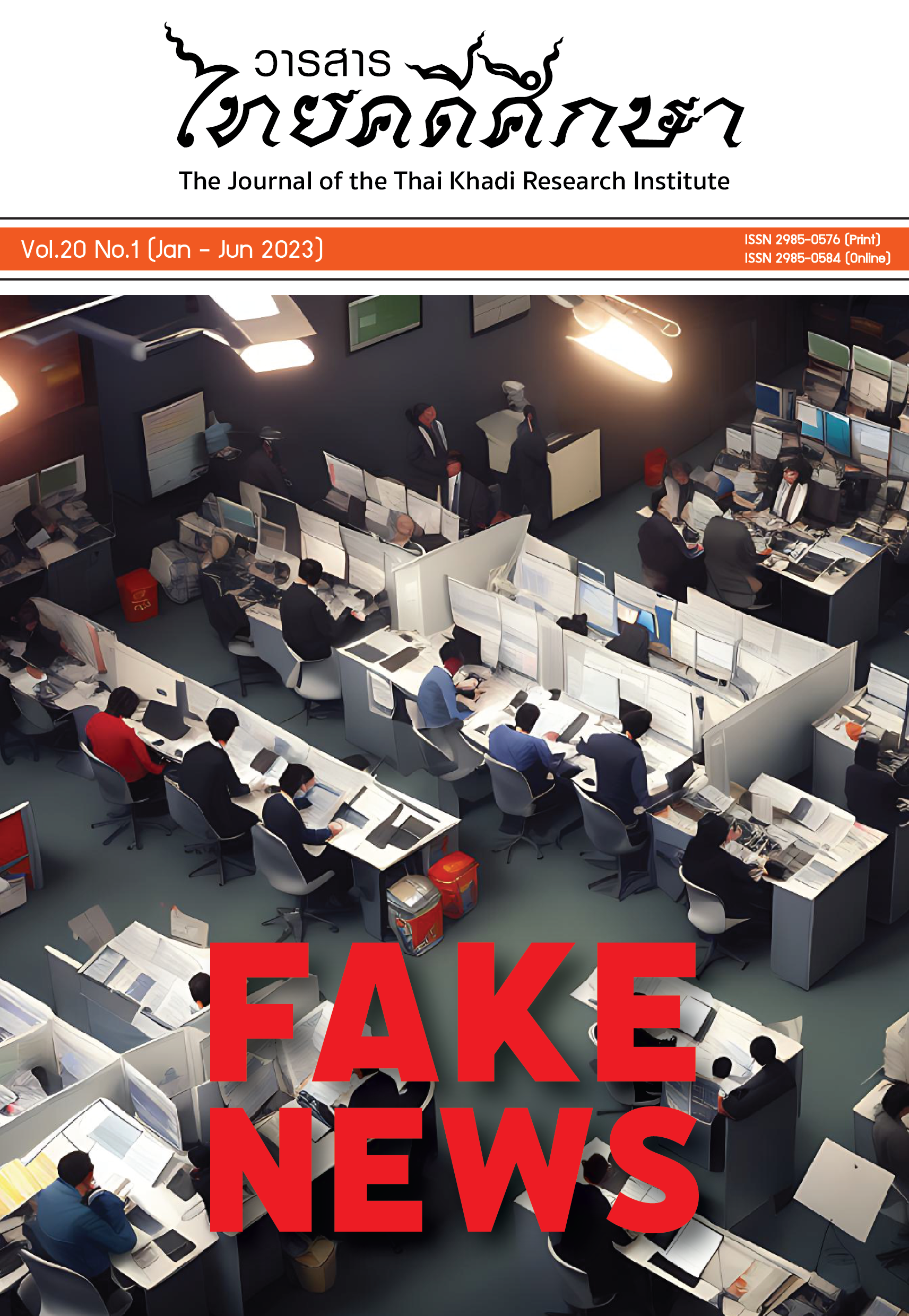Television Newsroom Culture in Thailand for Fact - Checking Disinformation
Main Article Content
Abstract
Disinformation (sometimes called fake news) has become normalized in the digital media age, to the point where it becomes challenging to issue accurate information to society at a comparable rate. With the burden placed on Thai consumers to be aware of disinformation, fact-checking acquires added significance for socially responsible journalists. This article studies the working culture of Thai television newsrooms, how news is made and what mechanisms check for disinformation. The goals are to 1) explore the process by which Thai news editors detect disinformation mechanisms; and 2) create a defense mechanism against disinformation in the media ecosystem.
Results were that television newsrooms in Thailand have a hierarchical newsmaking culture adhering to analog era editorial structure and production processes, with a director of news, deputy director of news, executive editor, assistant editor, producer, editor, and reporter. Yet there is no fact checker to discern real news from disinformation. News editors assert that fact-checking is primarily a reporter's duty, and all editorial office staff, including editors, assistant editors, and news rewriters, are expected to verify items before they are presented to the public. In addition, no television newsroom in Thailand has a defined policy to debunk disinformation. In cases when a major incident affects many viewers, the public will be duly informed that it is a matter of disinformation.
Downloads
Article Details

This work is licensed under a Creative Commons Attribution-NonCommercial-NoDerivatives 4.0 International License.
There is no charge for paper processing and publication. Once the paper is under peer-review process, however, if the paper is withdrawn for any reason the author will be responsible for the expense of 3,000 Baht occurred in the review process.
References
Allan, L., Alan, M. & Orna, Y. (2018). What is fact-checking and why is it important?. Retrieved August 6, 2021, from https://coinform.eu/what-is-fact-checking-and-why-is-it-important/.
American Press Institute. (2021). Journalism as a discipline of verification. Retrieved August 12, 2021, from https://www.americanpress institute.org/journalism-essentials/verification-accuracy/journalism-discipline-verification/.
Andrea Renda. (2018). The legal framework to address “fake news”: possible policy actions at the EU level. Retrieved August 6, 2021, from https://www.europarl.europa.eu/RegData/etudes/IDAN/201 8/619013/IPOL_IDA(2018)619013_EN.pdf.
Ballotpedia. (2018). What is fact-checking?. Retrieved September 8, 2021, from https://ballotpedia.org/What_is_fact-Checking.
Beckett, C. (2017). Fake news: the best thing that’s happened to journalism. Retrieved August 6, 2021, from https://blogs.lse.ac.uk/polis/2017/03/11/fake-news-the-best-thing-thats-happened-to-journalism/.
Edson, C., Tandoc, Jr., Zheng, W. & Richard, L. (2017). Defining “Fake News”, Digital Journalism, 6(2), 137 - 153.
European Commission. (2017). Next steps against fake news: Commis sion sets up High-Level Expert Group and launches public consultation. [online] Retrieved August 6, 2021, from http://europa.eu/rapid/press-release_IP-17-4481_en.htm [accessed 03/ 04/2018].
European Commission. (2018). Final report of the High - Level Expert Group on Fake News and Online Disinformation. Retrieved August 9, 2021, from http://ec.europa.eu/newsroom/dae/docu ment.cfm?doc_id=50271 [accessed03/04/2018].
Graves, L. & Amazeen, M. (2019). Fact - Checking as Idea and Practice in Journalism. Retrieved August 24, 2021, from https://oxfordre.com/communication/view/10.1093/acrefore/97801902 28613.001.0001/acrefore-9780190228613-e-808.
Graves, L. (2016). Deciding What’s True: The Rise of Political Fact - Checking in American Journalism. New York: Columbia University Press.
Graves, L. (2018). Boundaries not drawn: Mapping the institutional roots of the global fact - checking movement. Journalism Studies, 19(5), 613 - 631.
Graves, L. & Anderson, C. (2020). Discipline and promote: Building infrastructure and managing algorithms in a “structured journalism” project by professional fact-checking groups. New Media & Society, 22(2), 342 - 360.
Ireton, C. & Posetti, J. (2018). Journalism, fake news & disinformation: handbook for journalism education and training. Retrieved August 6, 2021, from https://digitallibrary.un.org/record/1641987# record-files-collapse-header.
Lewandowsky et al. (2020). The Debunking Handbook 2020. Retrieved August 6, 2021, from https://www.climatechangecommunication. org/wp-content/uploads/2020/10/DebunkingHandbook2020.pdf.
Lowrey, W. (2017). The Emergence and Development of News Fact - checking Sites. Journalism Studies, 18(3), 376 - 394.
McQuail, D. (2005). McQuail’s Mass Communication Theory (5th ed). Oxford London: SAGE Publications.
Posetti, J. & Matthews, A. (2018). A short guide to the history of ‘fake news’: A learning module for journalists and journalism educators. Retrieved August 22, 2021, from https://www.icfj.org/news/short-guide-history-fake-news-and-disinformation-new-icfj-learning-module [accessed 23 / 07 / 2018].
Tambini, D. (2017). Fake News: Public Policy Responses. Media Policy Brief 20. London: Media Policy Project, London School of Economics and Political Science. Retrieved September 6, 2021, from https://core.ac.uk/download/pdf/80787497.pdf?fbclid=IwAR2plmI 40dVo wxO.
Waisbord, S. (2018) Truth is What Happens to News. Journalism Studies, 19(13), 1866 - 1878.
Waisbord, S. (2018). Truth is What Happens to News: On journalism, fake news, and post - truth. Journalism Studies 19(53), 1 - 13.
Interviewees
Bunyapanich, K. (2020, January 12). Editor of investigative news group, Thai PBS Television Station.
Cha-em, S. (2020, January 18). Deputy Director of News, Amarin Television Station.
Khaengkhan, B. (2020, January 17). Editor - in - Chief, Channel One 31 News Television Station.
Khunthong, W. (2020, January 13). News Editor, Thairath TV Television Station.
Pri - Ngam, C. (2020, January 9). News Editor, Channel 3 Television Station.
Thongnak, J. (2020, January 10). Deputy Manager of News Department 2, Channel 7 Television Station.
Wiriyaphanpongsa, S. (2020, January 7). Executive Editor, PPTV Television Station.


